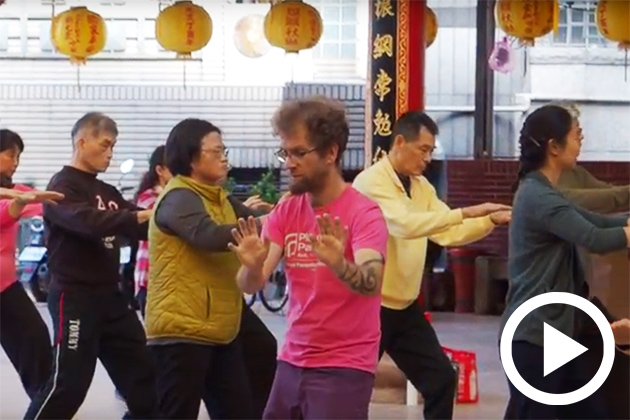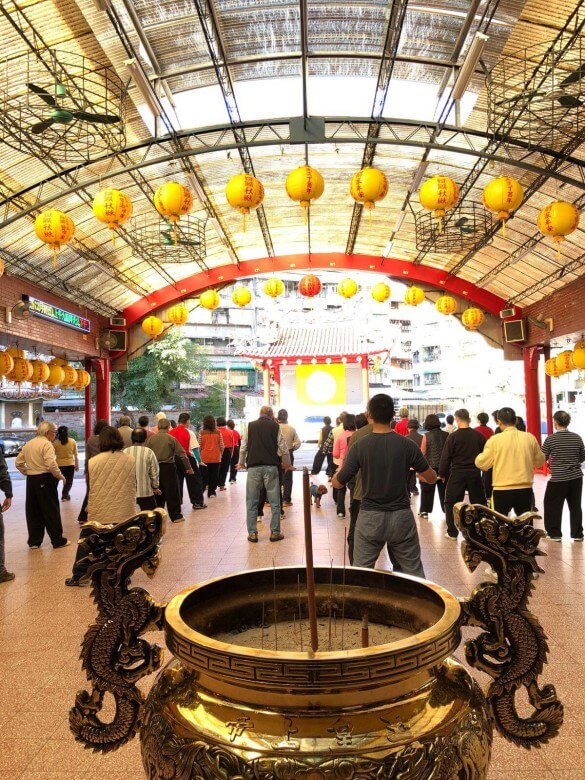Reflexive Taiwan Series
My Taiwanese Tai Chi Experience

Source:Taiwan Scene
Joshua Samuel Brown, co-author of twelve Lonely Planet guides, started his "long and slow" Tai Chi journey, not just to delve deeper into the mysteries of Chinese culture, but also because he doesn't want his Tai Chi classmates think he's a quitter.
Views
My Taiwanese Tai Chi Experience
By Taiwan Sceneweb only
If you’ve spent any time at all in Taiwan or China, you’ve probably seen Tai Chi being practiced in parks, usually in the early morning by anything from single practitioners to large, semi-choreographed groups. For the past month or so I’ve been practicing Tai Chi myself three mornings a week, and I thought I’d use this week’s column to share my experience.
As I’m not an expert (indeed, after four weeks of practice I feel as if I know less about the subject than I did before I’d started), I’ll clip a quick paragraph from Wikipeida’s Tai Chi page before getting into my own humbling (and yeah, sometimes humiliating) insight about Tai Chi.
Tai chi (taiji), short for t’ai chi ch’üan (taijiquan; 太极拳), is an internal Chinese martial art practiced for both its defense training and its health benefits. The term taiji refers to a philosophy of the forces of yin and yang, related to the moves. Though originally conceived as a martial art, it is also typically practiced for a variety of other personal reasons: competitive wrestling in the format of pushing hands (tui shou), demonstration competitions, and achieving greater longevity.
Here’s how I started the practice:
A few months back I moved into an apartment located next to a fairly lively temple in the wilds of Muzha, not too far from Maokong. Within the first few days of living there, my partner and I both noticed a gentle music wafting up from the temple courtyard on weekdays. One morning I brought my coffee down to investigate, and saw a group of about three dozen people in a grid formation beneath the temple’s awning all doing what to the uninitiated eye might appear to be a slow waltz. One of the practitioners invited me to join them, and I told them I’d come for the next day’s class.
It’s here that I should point out a few things.
1) I am dyslexic in any language, and have trouble keeping left and right and 左 and 右 straight for any length of time,
2) Two, I’m not generally a fan of waking up early, and
3) I suck at group activities.
Still, I decided I’d not just go to the next days class, but make a commitment to myself to go at least three times a week for the next month. Part of the reason was because I’d already heard a great deal about the health benefits of Tai Chi. Years ago I’d had a friend in Colorado who was a daily practitioner and spoke glowingly about the beneficial effects on mind, body and spirit. (Then again, he also spoke glowingly about the beneficial effects of chi retention, something I’d actively avoided since hitting puberty. But I digress.) Another reason is that I felt that practicing this most quintessential of Chinese activities would be beneficial in my own quest to better integrate into the Chinese-speaking world in general.
 Image: MyTaiwanTour
Image: MyTaiwanTour
I showed up bright and early on the first day, joining my fellow practitioners in a series of coordinated exercises, all to the sounds of a melodic taped recording rattling off instructions.
Inhale….left leg out….exhale…left leg in…
Inhale….roll head forward….exhale….roll head backwards….
I was surprised that I was actually doing the exercises more or less in sync with the rest of the students.
Only when the Shifu arrived, clad in his white jumpsuit bearing the logo of his school, did I realize that we’d just been doing the pre-class warm-up.
As the Shifu made his way to the front of the group, each member straightened up, hands behind back. One of the students yelled out. “Shifu is here. Class will begin!”
At that, my new classmates greeted first the Shifu and then their fellow classmates in the traditional greeting, grasping fist in open palm and shouting “Good Morning Teacher” and “Good Morning Classmates.”
My first lesson had begun in earnest. One of the students pressed play on the tape recorder, and the gentle music I had been hearing over the past several months began.
“We begin with the 13 poses,” our Shifu said, and I did my level best to follow along with the rest of the class as they went through the graceful and interconnected series of moves that taken in their entirety make up the 13 poses exercise. Though my movements were neither graceful nor interconnected, from my position way in the back of the class and next to the temple’s massive incense brazier I was able to basically copy the movements of the students in front of me. But the 13 poses exercise requires circular movement, and once the group had moved past the first sequence and turned, I found my position suddenly not behind the group and looking forward but before the group with nobody to copy, making it clear to myself and all involved that the basics of the 13 poses was something I’d need before any level of mastery might be gained.
 Image: MyTaiwanTour
Image: MyTaiwanTour
I realized that I was 一竅不通 (yīqiàobùtōng), or out of my depth. But I wasn’t alone. Shortly thereafter, I, along with (thankfully) a number of other newcomers, was brought out of the main group to the far side of the temple plaza to join the beginners group, which I immediately dubbed yo yo ban (nursery school). There, under the patient tutelage of one of the Shifu’s older students, we spent the next hour running through the basics of the 13 poses. While running through the basics, I watched from the corner of my eye the main group engaging in the graceful partner exercises known as tuishou (“pushing hands”), which clearly offered useful martial applications.
This was merely the first class, and since then I’ve spent three mornings a week with the group, beginning each class with the warm up exercises before retreating to the safety of Yo Yo Ban to continue getting down the basics of the 13 poses. Though I’ve joined the main group for the daily 13 poses sequence, once the class progresses to tuishou I still feel out of my depth, and apparently Shifu feels the same way since I’ve yet to be forced to graduate into the main group.
While I find some of the moves fairly easy to grasp, other parts of the sequence (specifically those involving changing direction) still seems to confound my overall dyslexic sensibility.
“Left foot forward, right foot back” The teacher’s assistant of the day will say in Chinese, and by the time the direction has run through my internal translator I’ve done the opposite. And honestly, I’m not sure whether or not I’ll ever be ready to leave the safety of tai chi nursery school and begin practicing tuishou with the main group anytime soon.
But the study of Tai Chi is giving me great general insights into Chinese culture, a few of which I’d like to share.
Tai Chi is full of contradictions
Tai Chi, like so many other aspects of Chinese culture, is simultaneously incredibly simple and infinitely complex. The exercises are simple, but must be done precisely. The movements are peaceful, but can, if called upon, be used for martial purposes. “You’re doing great” (according to one of my student teachers) and also “You should continue in Tai Chi Nursery School before joining the main group” (the same teacher in the same breath).
Togetherness is key
While the class is made up of a small core group of regulars who’ve clearly been studying for years, most of my fellow students seem to fall somewhere between awkward beginners just slightly less beginner-y than myself and beginner-intermediate level. Outside of the core group, everyone seems to be looking at everyone else for guidance and affirmation that their own movements aren’t too far off the mark. This concept, rendered in Chinese as 同心協力 其利斷金 (Tóngxīn xiélì qí lì duàn jīn, or “working together is where the greatest profit lies”) is a key concept in Chinese culture.
The rules are consistent, except when they aren’t, and it’s fine if you didn’t know that but really, it would be better if you did.
During the first two weeks of our class we worked on the 13 poses, which I was just starting to get when all of a sudden we switched to another set called I think the 19 poses or 39 poses or something, which really I should have gotten because the music suddenly changed.
This is just for fun and health, so don’t worry if you suck at it. Also, there will be a performance coming soon, and we expect you to participate.
This last bit was sprung on me during Tuesday’s class. Also, I was told that I should try to make it to class more often, and that I’d be expected to buy a fan to train for “the fan dance” portion of the performance.
It’s OK that you can only commit to 3 mornings a week and also, you really should come five mornings a week.
Because I really need to progress past the Tai Chi Kindergarten phase. Also, apparently I’ll be asked to purchase a fan on Monday.
So I’m committed to keep with the Tai Chi lessons, not just because I hope to both improve myself and delve deeper into the mysteries of Chinese culture, but also because I have to pass by the group on my way to work and wouldn’t want them to think I’m a quitter.
Also, I paid for three months of classes in advance, and will be expected to shell out NT150 for the aforementioned fan next Monday.
Below, a short film made by the incredible Will Tang at Going Awesome Places Blog. Will, along with his wife Chantelle, were my guests on a tour of Wulai this Thursday. They took tons of photos of the class (including the two on this page), and wound up learning more in 90 minutes than I’ve managed to learn in the past month, further cementing my inferiority complex.
Until next week, keep practicing.
Looking to experience traditional martial arts in Taiwan? Let MyTaiwanTour custom design your travel itinerary to include visits to the temples and parks in which the ancient arts are still practiced.
What's your #Taiwander story?
Share it with us, let us broadcast it to the world through CommonWealth Magazine and then find yourself on an exciting MyTaiwanTour this year! (Click the picture below for more details.)
Additional Reading
♦ For Me, Movement Defines Taipei
♦ Traveling in Taiwan as A Woman (But Not Only)
♦ 'Don't Give Up A 5000-Year Cultural Heritage For A 50-Year Political Shift'
About Taiwan Scene
Taiwan Scene is the online journal of MyTaiwanTour.
We publish stories introducing readers to the culture, scenery and travel possibilities of our homeland, articles to help travelers make the most of their time in Taiwan, and occasional interviews with movers and shakers from Taiwan’s ever-expanding creative scene.
Prolonged exposure to Taiwan Scene may instill in readers a profound desire to experience Taiwan personally. If these cravings persist, please contact us immediately.

Original content can be found at the website of Taiwan Scene.
♦ The Taipei Tai Chi Experience
This article is reproduced under the permission of Taiwan Scene and terms of Creative Commons Attribution-NonCommercial-NoDerivs 4.0 Unported License (“CCPL”). It presents the opinion or perspective of the original author / organization, which does not represent the standpoint of CommonWealth magazine.








